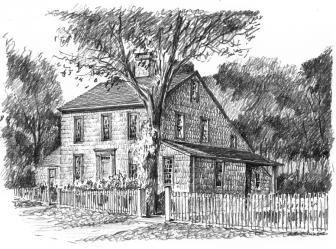The preservationists who pledged to save a historic home on Ferris Hill Road have just one week left before its owner can pursue a demolition of the 1735-built, wood-frame saltbox farmhouse.

Sketch of 8 Ferris Hill Road, present-day, by Mark Markiewicz
Known as the “Hoyt-Burwell-Morse House,” the single-family dwelling at 8 Ferris Hill Road (it’s listed at 441 Canoe Hill Road in the assessor’s database, same property) has been under a 90-day demolition delay since members of the 8 Ferris Hill Road Group and others successfully argued before town officials that it has historical, architectural or cultural significance, as per the Town Code.
That delay expires June 1, and it isn’t clear whether the property’s owner will pursue demolition as soon as he can. Reached by NewCanaanite.com, Max Abel—who has said he regrets ever purchasing the 2.14-acre property—declined to comment, citing a “highly sensitive” situation.
The preservation group has said it intends to acquire the property and sell it on, though it has found itself facing practical hurdles to doing so, and is still working toward clearing them.
Rose Scott Long, one member of the preservation group, said: “Basically, we need to stop the clock on the demolition of the house. To accomplish that goal, we are developing a viable strategy which includes two major elements—one is the entity which will hold title to the property once we acquire it, and two is a financial plan which will see us through from the time we acquire the property to the moment we transfer the property to a happy new homeowner.”
An application has gone into the Connecticut Commission on Culture and Tourism to include the home on the CT State Register of Historic Places.
According to the application, the home is significant “for its contribution to the settlement of New Canaan, Connecticut.”
It continues: “According to a history written in 1947, the land upon which the home stands was a portion of a large division belonging to the sons and nephews of Joseph Hoyt,” the application said. “This tract included approximately all of the Canoe Hill road from where it leaves Carter Street, East, West, and North into Laurel Road.
“The Hoyts represent the beginning of a movement to resist the long commute from Norwalk to Stamford for church services. To cut down on travel time, a congregation was organized and named Canaan Parish. “The town of New Canaan grew from this congregation and was chartered in 1889. The New Canaan Historical Society’s survey suggests that there are only six other residences built before the Hoyt-Burwell-Morse House that are still standing. A generation of Hoyts built their homes along the ridge where the Hoyt-Burwell-Morse House now sits on and it became known as ‘House Ridge.’ This home is all that is left to show of this settlement and movement.
“Between the creation of the home and the town’s establishment, the house was occupied by several noteworthy families, mostly descendants of the first settlers of “House Ridge”. These settlers had significant names to the successful creation of New Canaan such as, the Hoyts, the Benedicts, the Burwells, Carters and the Steven. Many of these names are tied to key social, political or economic leaders for the growing area. Some were founders of the Canaan Parish, soldiers, pioneers or businessmen.
“A town historian also believes the house was once occupied by Onesimus Comstock, a man born into slavery in New Canaan in 1761 and said by some to be the last living slave in Connecticut. Comstock had identified himself as a “voluntary slave” in the 1850 census for Norwalk and is buried in the nearby Canoe Hill Cemetery. He died at age 97 in 1857.
“The home continued to house the town’s significant families well beyond the time the town was chartered in 1889. This can be seen even in the landscape surrounding the home. Gilbert Birdsall, who owned the third avenue street railway line in New York purchased the house for his daughter upon marrying Franklin Stevens and the two planted sugar maples in the front yard which can still be seen. These were called ‘Bridal Maples’ and were commonly planted when a young couple went to live in their new home.”